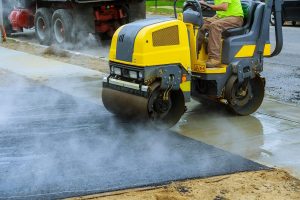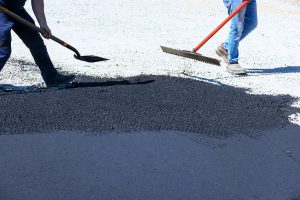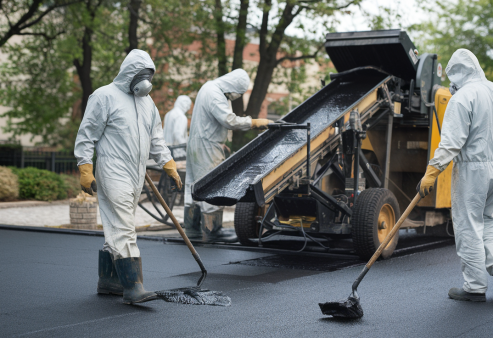How to Choose Between Hot Mix and Cold Mix Asphalt
Table of Contents 1. Key Takeaways 2. Understanding Asphalt Types What is Hot Mix Asphalt? What is Cold Mix Asphalt? Key Differences in Composition and Application 3. Performance ...

Experienced Professionals Delivering High-Quality Asphalt Services
Residential License # 890459
Commercial License # 3667

Call Us Today!
Asphalt driveways are popular for their durability, but eventually, they all wear out. Even with good care, there comes a point when maintenance isn’t enough anymore. Here are clear signs it’s time for a full repave with expert help from TurnKey Asphalt.
From noticeable cracks that mar the surface to subtle sagging that indicates deeper issues, we’ll help you know when it’s time to repave your asphalt instead of just patching it up.
If you’re noticing any of these signs, don’t hesitate—contact TurnKey Asphalt today for a consultation and ensure your driveway remains safe and attractive.
If your asphalt driveway is full of cracks, it’s time to repave. Ignoring this can lead to bigger, costlier problems down the line.
 Structural Concerns: However, when cracks spread across the surface, the situation changes. Widespread cracks signal serious problems beneath the surface. This damage hints at structural concerns. Ignoring signs that your driveway’s foundation is at risk could lead to more significant problems later.
Structural Concerns: However, when cracks spread across the surface, the situation changes. Widespread cracks signal serious problems beneath the surface. This damage hints at structural concerns. Ignoring signs that your driveway’s foundation is at risk could lead to more significant problems later.Potholes are a nuisance and indicate that your asphalt driveway needs attention. When they appear, it’s time to repave for a long-lasting and safe driveway.
If water collects on your asphalt driveway and doesn’t drain properly, it’s likely time to repave. Standing water can cause significant damage.
 Base Erosion: Poor drainage doesn’t just affect the surface. It erodes the base of your driveway, compromising the entire structure. You’re not just dealing with surface-level issues anymore; the foundation of your driveway is at risk. The longer the water remains, the more damage it does.
Base Erosion: Poor drainage doesn’t just affect the surface. It erodes the base of your driveway, compromising the entire structure. You’re not just dealing with surface-level issues anymore; the foundation of your driveway is at risk. The longer the water remains, the more damage it does.Fading and discoloration on an asphalt driveway are not just cosmetic problems. They indicate wear and tear happening beneath the surface. When you see these signs, it’s time to repave your driveway.
The age of your driveway is a clear indicator of when it needs a repaving job. Over time, asphalt driveways show signs of wear and tear.
 Signs of Aging: Cracks and uneven surfaces become more common in an aging driveway. These aren’t just cosmetic issues; they indicate that the driveway’s foundation is compromised. An old driveway may also struggle with drainage, leading to water damage and further asphalt breakdown. Regular repairs might seem like a solution, but they often only provide temporary relief for a larger problem.
Signs of Aging: Cracks and uneven surfaces become more common in an aging driveway. These aren’t just cosmetic issues; they indicate that the driveway’s foundation is compromised. An old driveway may also struggle with drainage, leading to water damage and further asphalt breakdown. Regular repairs might seem like a solution, but they often only provide temporary relief for a larger problem.If your driveway has cracks, potholes, or puddles, it’s time to repave. These issues are serious and can lead to bigger, more expensive problems. Repaving isn’t just for aesthetics; it’s essential to handle heavy use and weather damage over time.
It’s an investment that enhances your home’s appearance, safety, and value. Don’t wait for irreversible damage. Transform your driveway into a stunning entryway that welcomes you home every day.
Reach out to TurnKey Asphalt today for a free consultation and let us help you create a durable, attractive driveway that boosts your curb appeal!

Table of Contents 1. Key Takeaways 2. Understanding Asphalt Types What is Hot Mix Asphalt? What is Cold Mix Asphalt? Key Differences in Composition and Application 3. Performance ...


Table of Contents 1. Key Takeaways 2. Recognizing Early Signs of Asphalt Wear a. Identifying Small Cracks and Splits b. Spotting Surface Discoloration and Fading c. Detecting Water P...


Keeping your asphalt driveway in excellent condition throughout the year doesn’t have to be overwhelming. With simple steps and a proactive approach, you can protect your driveway from wear caused ...


Asphalt, a vital part of our roads and driveways, faces constant challenges from the weather. From the intense heat that softens it to the freezing cold that causes cracks, and the ongoing freeze-t...


Asphalt has proven its durability from ancient Roman roads to modern-day parking lots. Understanding its lifespan is key to saving money and maintaining the aesthetic of your property. Several f...


Choosing the perfect material for your driveway is key to saving money and ensuring satisfaction with the final result. Both asphalt and concrete are popular options, each with its own set of advan...
